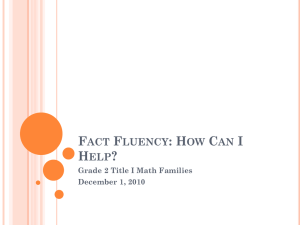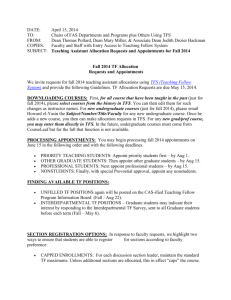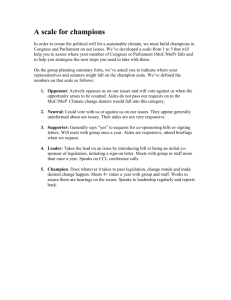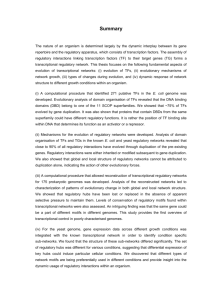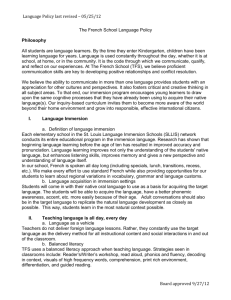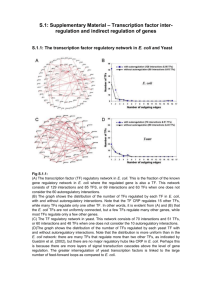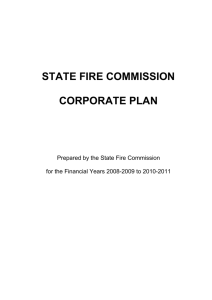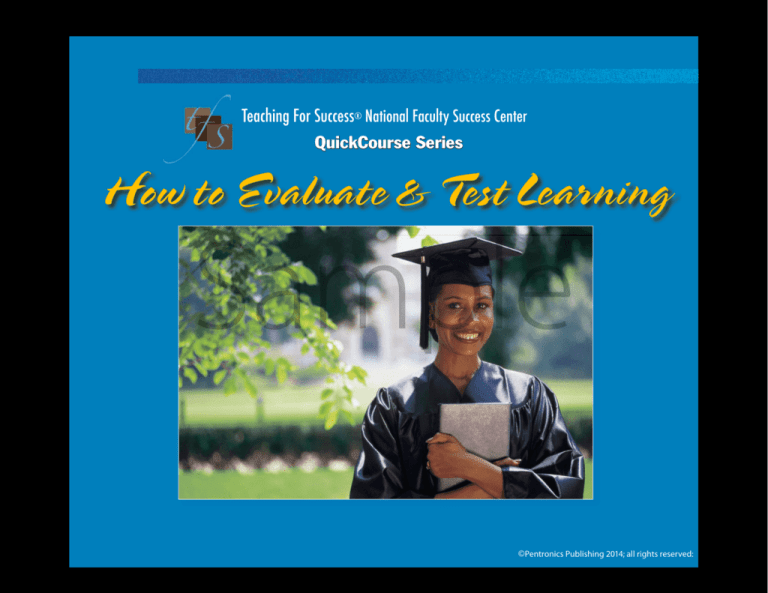
Teaching For Success® National Faculty Success Center
QuickCourse Series
How to Evaluate & Test Learning
Sample
©Pentronics Publishing 2014; all rights reserved:
A TFS QuickCourse
T
his QuickCourse will help
you ensure that you are
selecting and/or creating
quality tests that will evaluate the performance of your
students in a valid and
meaningful way. Testing is
the crucial fifth Critical Success Factor of good teaching
and learning.
How to Test and Evaluate Learning
Written by
Kay Rooff-Steffen, Coordinator of Humanities, Communication and Fine Arts, TFS
Study Sections
Partner Author, Eastern Iowa Community College District, Muscatine, IA.
Brian R. Shmaefsky, Ph.D., Professor of Biology, TFS Partner Editor, Science and
(Click to Go)
Technology, Lone Star College, Kingwood, TX.
Michael Griffith, PA.
Overview
Testing Basics
Jack H. Shrawder, Publisher, Teaching For Success, South Lake Tahoe, CA.
Sample
S
the busy, caring part- or full-time instructor who desires to
develop teaching skills, but must make every minute devoted
to professional development count. This self-study course will
give you the fundamental knowledge you need to be comfortable and competent in the area of testing and evaluation.
Edited by
Michael Griffith, PA.
Testing Talk
Test Planning
Question Construction
Course Test Planning
References
Job Aides
Answers
Contact Information
Jack H. Shrawder, Publisher, Teaching For Success, South Lake Tahoe, CA.
What this course can do for you.
After completing this QuickCourse you should know:
The purpose of testing.
Common test and evaluation terms.
What a test should accomplish.
How to use a TFS (TPAG) Test Planning and Analysis Grid to check the balance of your tests.
What question words correspond to various
levels of learning achievement as described in
Bloom’s taxonomy.
How to evaluate test questions.
How to estimate the proper length for a test.
How to create a Course Testing Plan.
How to use the TFS Course Testing Planning Grid
to create a good course testing plan.
Resources for more detailed testing information.
ection 1.Overview
S
tudent arguments, complaints and disappointments over testing are all a possibility during any
course, unless you have developed a sound working knowledge of the evaluation and testing skills required to be a
successful instructor. Conflict occurs because students care
deeply about tests and test results, since they so profoundly
affect their academic careers. When I talk with students, I find
poorly written, tricky and ambiguous or irrelevant test questions are at the top of the list of students’ complaints about
their instructors. Students deserve good, fair tests, and this
QuickCourse can help you create them for your students.
This Teaching For Success QuickCourse is designed for you,
2
A TFS QuickCourse
Study Sections
(Click to Go)
Overview
Testing Basics
Testing Talk
Test Planning
Question Construction
Course Test Planning
References
Job Aides
Answers
Contact Information
A
s far as students are
concerned, the most
important instructional decisions you make are about
testing. By making better
testing decisions you will
produce more accurate
and reliable measures of
student learning achievement.
Is this Quick Study for me?
The first principle of effective test design is overcoming
the notion that testing merely involves writing a set of questions. In truth, it starts with specific, defined course outcomes that are linked to effective lesson plans and based
on a sound learning model such as Bloom’s Taxonomy.
Good testing is an outgrowth of a well-organized course
that helps students study, understand, apply and retain
what has been learned. Therefore, tests should never be
constructed as a guessing game for students.
Sample
Rules for test writing are reenforced with sample objective-style questions demonstrating good and bad question
construction techniques. Finally, test-length factors are conApplicability
sidered, a course testing plan is presented and links to sevThis QuickCourse is designed for the instructor in any dis- eral testing websites are provided.
cipline who is faced for the first time with the tasks of planning, creating or selecting test questions and test types and Main Study Topics
administering tests in their classrooms.
Testing talk: What do common testing and evaluation
terms mean?
Time required
Planning a test: What do you want the test to do?
Question construction: How do you write or select
You should devote about 60-90 minutes to reading
and interacting with this QuickCourse. You will be asked to
good, clear, concise and valid test questions?
answer questions, then practice applying this new knowl Test length: How to estimate the length of a test.
Course testing plan: How to create a course testing
edge to improving a test you created or selected from a
test-question bank. You can practice writing test questions
guide.
Self-test: Check your understanding of the terms, recin interactive text fields. If time is short, just take it one section at a time.
ommendations and principles contained in this QuickCourse.
Instructional design
References: Book and articles that can provide more
The learning process in this QC starts with a considertesting details.
Job aides: Blank TFS test design and planning forms.
ation of the three functions of tests, then moves on to creating a testing plan based on the six learning levels described
by Bloom’s Taxonomy.
3
A TFS QuickCourse
S
ection 2. Testing Basics
Study Sections
(Click to Go)
Overview
Testing Basics
Testing Talk
Test Planning
Question Construction
Course Test Planning
References
Job Aides
Answers
Contact Information
T
ests should never be
seen by your students
as a guessing game or an
exercise in interpreting ambiguous questions.
Questions should be
clear, straight forward and
understandable. Good tests
begin with good learning
objectives.
S
ince childhood, for many of us, the word “test”
or “exam” has been a stress-producing trigger
word. Tests are dreaded by some students and faculty alike.
Therefore, testing is an emotionally-charged subject for students.
Sample
Poor tests and questionable questions will evoke more
Learning objectives
student disagreements and arguments than any other
One of the most logical ways to look at testing is to recteaching and learning activity. This QuickCourse will help you ognize that test items are really learning objective stateimprove your tests and your students’ satisfaction with the ments transformed into questions.
way you evaluate them.
Quality tests depend on quality learning objectives. If
You may assume that since you have taken a plethora of you don’t know or can’t define or express precisely what
tests throughout your academic career that you know how to students must know, do or choose, how can you develop
create a good, fair test. If so, you have discovered or are about accurate tests to measure learning achievement? So jobto discover that testing and evaluation is a complex subject one is to be able to write or identify learning objectives. If
and demands learning a body of knowledge and applying you are new to teaching and have not been given a list of
some practical skills.
learning objectives or expected outcomes for your course,
ask your department head if such a list exists. If you fail to find
You have experienced (or if new to teaching, about to expe- a prepared list for your course, check the course textbook.
rience) the grief that poorly constructed or planned tests can Some instructor’s text editions will list learning objectives.
cause students and instructor alike. Without a basic familiarity
with good testing principles, you may feel the burden of wonA formal learning objective statement has three parts:
dering whether or not your tests adequately evaluate student
Starting conditions. (Where do you start?)
Action. (What will the learner do with the learned
knowledge and comprehension. This QuickCourse will give you
knowledge, skills or attitudes.)
the tools so that you can know for sure that you are doing a
Performance standard. (How well­ will the learner
professional job in testing and evaluation.
do it?) Possible time or accuracy standards stated.
4
A TFS QuickCourse
A
s an instructor in
higher education it’s
very important to understand common test and
evaluation terminology in
order to talk productively
with your peers and administrators about testing
issues.
Example three-part Learning Outcome
Study Sections
(Click to Go)
Overview
Testing Basics
Testing Talk
Test Planning
Question Construction
Course Test Planning
References
Job Aides
Answers
Contact Information
G
iven (starting conditions) a PC with a text editor
without a spell checker installed, the student will
be able to (what learner will do) write a paragraph
in a five minutes consisting of a topic sentence, and
four supporting sentences.
The paragraph will (performance standard—
how well) conform to standard grammar rules with
no more than two grammar or punctuation errors and have no more than one word misspelled.
Sample
Tests should never be a guessing game for students.
Questions should be clear, straight forward, understandable and congruent with the material students must learn.
Students should never have to ask, “Will this be on the test?”
Your syllabus, lesson plans and learning activities should all
Granted that writing a formal, three-part learning objec- make it very clear to students what and how learning will
tive (Given, Do, Standard) at this level of detail takes consid- be evaluated.
erable time and effort and therefore, may be an impractical
task for many part-time faculty. But the principle of specify- Not an option
For most of us, we are forced to test by our institutions
ing learning outcomes is a sound instructional design and
testing principle. To ensure quality testing, it is essential that and federal or state licensing boards or agencies. Paper
you have a list of learning objectives or learning outcomes or computer objective and subjective tests are the most
common form of evaluation used today at all educational
available prior to the preparation of each test.
levels. So, whether to test is not usually an option, but you
do have the option to decide how and oftentimes when to
More than off-the-cuff questions
The first principle of effective testing is dismissing the test and what the results mean.
notion that testing merely involves writing or selecting a
Some instructors rely solely on tests extracted from an
bunch of clever or tricky questions. Rather, good testing is
an outgrowth of detailed course and lesson planning. Tests instructor’s edition of a textbook, but these pre-made tests
should be based directly on what your students must learn are geared toward the average student taking an average version of the course. Therefore, they may not ensure quality testand what performance levels must be achieved.
ing unless the questions are evaluated and selected according
to a criteria based on a specific course and student group.
5
A TFS QuickCourse
Study Sections
(Click to Go)
Overview
Testing Basics
Testing Talk
Test Planning
Question Construction
Course Test Planning
S
ince you are an individual and unique
teacher, chances are your
classes reflect your specific
strengths and experiences
and testing style.
The best way to express your unique evaluation style is to learn how
to create good, fair tests.
Since you are an individual and unique teacher, chances
are your classes reflect your specific strengths and experiences. Your tests should therefore reflect your special
approach, and often, the only way to accomplish this is to
create tests from your own test questions.
Whether you are faced with the task of writing test questions from scratch, selecting questions for a test from a bank
of publisher-supplied test questions or choosing a test from
those offered by your textbook publisher, the information
in this QuickCourse will help you evaluate your students with
Why is a list of learning objectives or learning outcomes
a high quality test.
essential to have before a test is created? Write your answer
in the field below.
Your turn
Sample
Describe in a few brief sentences in the text field below
the most pressing problems that you face with testing and
evaluation.
Name the three parts of a formal learning objective
statement?
Part 1.
References
Part 2.
Job Aides
Answers
Part 3.
Contact Information
Answers?
Click here to go to answers.
6
A TFS QuickCourse
S
ection 3.Testing Talk
Study Sections
(Click to Go)
Overview
Testing Basics
Testing Talk
Test Planning
Question Construction
Course Test Planning
References
Job Aides
Answers
Contact Information
Y
ou’ll find it helpful to
be comfortable with
testing terms when conversing with fellow faculty,
administrators and for
easy reading of reference
materials. These are testing and evaluation terms
you should know and use
in professional discussions.
How’s Your Testing Talk?
Testing theory and practice has its own special terms that
may need some getting used to. If you are new to testing
and test terminology, you’ll find it helpful to be comfortable
with the terms when conversing with fellow faculty, administrators or for easy reading of reference materials. These are
testing and evaluation terms you should know: (term links
are active):
Evaluation.
Formative evaluation.
Summative evaluation.
Diagnostic evaluation.
Test.
Measurement.
Performance.
Standard.
Reliability.
Validity.
Norm-referenced.
Criterion-referenced.
Objective-referenced.
Objective question.
Subjective question.
Sample.
Sample
Evaluation—This is the granddaddy term that means
using a systematic process to make a sound judgements about the value of something.
Formative evaluation—This type of evaluation is
used to create a progress report during a course
of learning. Quizzes, midterm exams, chapter takehome tests, journal reviews and portfolio critiques
could all be used in a formative evaluation.
Summative evaluation—One subdivision deserves
another. An evaluation that sums up the outcomes of a learning process at the completion
of the learning is a summative evaluation. A final
exam is usually part of a summative evaluation.
Diagnostic evaluation—And, there is even another
subdivision. This term describes a type of evaluation that is all too often neglected in the higher
education classroom. It is used to pinpoint learning problems or uncover gaps in knowledge or
skills that are preventing the student from progressing.
Here are the simplified, working definitions that we use
at Teaching For Success: Use these terms appropriately and
you will gain respect as a competent instructor!
7
A TFS QuickCourse
P
erformance—
Now, this is a term
that really piques the interest of an educational- behaviorist. Performance is
about results: How well?
How soon? How much
better? It’s worth the effort
to measure learning in
terms of performance.
Test—In testing circles, tests are referred to as
instruments that measure how well a learner
performs.
Study Sections
(Click to Go)
Overview
Testing Basics
Testing Talk
Test Planning
Question Construction
Course Test Planning
References
Job Aides
Answers
Contact Information
Measurement—When you measure something, you
get the results in numbers and units for example,
a piece of string with a length of 9 inches. Similarly, when you measure learning you use an
instrument that provides a numerical result.
Sample
Reliability—This term describes how well a test would
produce the same results if given to other groups of
students at different times and places. A reliable test
would yield approximately the same range of scores
and share similar mean scores whenever it’s given.
When you create your own tests you can expect
that their reliability will be low. The same test may
yield varying scores from use to use.
Performance—Now, this is a term that really piques
the interest of an Educational Behaviorist. Performance is about results: How well? How soon? How
much better? These are good performance questions. To be meaningful, performance should be
clearly defined and measured against a standard.
Standard—A most important testing concept.
When you think about standards in testing you
are pondering the question, How well must my
students perform and what will be the measuring
stick? You can create a test, but without setting or
choosing a standard, the results are meaningless.
Standards, for example, may be expressed in
percentage correct, or as a number or items or
actions to be completed in a specified amount
of time or how accurately work is accomplished
compared to a fixed model or list of tasks, or
compared to others performing the same action
in the same class or in all course sections.
How to Maximize Reliability
Add questions—reliability is generally better
with a longer test.
Provide clear, concise directions to help students make the best use of their time.
Check for score spread. If scores are bunched
in the upper or lower ends, reliability may be
poor.
Include a wide-range of difficulty when choosing test items.
Validity—This term is crucial to understand. Valid
tests measure what they are designed to measure.
8
A TFS QuickCourse
Study Sections
(Click to Go)
Overview
Testing Basics
Testing Talk
Test Planning
Question Construction
Course Test Planning
References
Job Aides
Answers
Contact Information
I
f your tests lack validity,
expect arguments and
challenges over correct
responses and what the
question is really asking.
When invalid tests are
used to make important
grading and competency
decisions, tragic errors can
result.
The importance of validity
Unless your tests are carefully planned, designed and
constructed, they will have low validity and fail to measure
the knowledge, skills or attitudes that you intend. If your
tests lack validity, expect arguments and challenges over
correct responses and what the question is really asking.
When invalid tests are used to make important grading and
competency decisions, tragic errors can result. Valid tests
are good, fair and accurate tests of the knowledge and skills
to be assessed.
Sample
Criterion- or objective-referenced—This type of
test measures the performance of a student
against a defined set of learning tasks or list
of learning objectives. Mastery learning uses
criteron-referenced tests to evaluate whether a
student has mastered an acceptable number of
learning objectives.
How to Maximize Validity
Ask a peer, friend or spouse to review the
questions and identify ones that are confusing or ambiguous.
Check question construction according to the
construction principles found in the “Question Construction” section of this course.
Use a test construction grid to match questions with learning objectives. Eliminate any
superfluous questions.
Ensure students know precisely how to answer
each question as well as the scoring and grading criteria.
Objective question—Objective questions are those
that can be scored without a detailed analysis
of the answer. Multiple-choice, fill-in-the-blank,
true-false, matching and one-word short answer
are all examples of objective test questions.
Subjective question—Objective questions are
those that must be scored by detailed analysis
and repetitive scoring process; whereas, essay
test questions are subjective questions. The
answers to subjective questions are subject to
the examiners opinion on the correctness of the
response.
Norm-referenced—A norm-referenced test measures the performance standing of an individual
in reference to the performance of a group.
When you grade on the curve you are norm-referencing the test.
9

